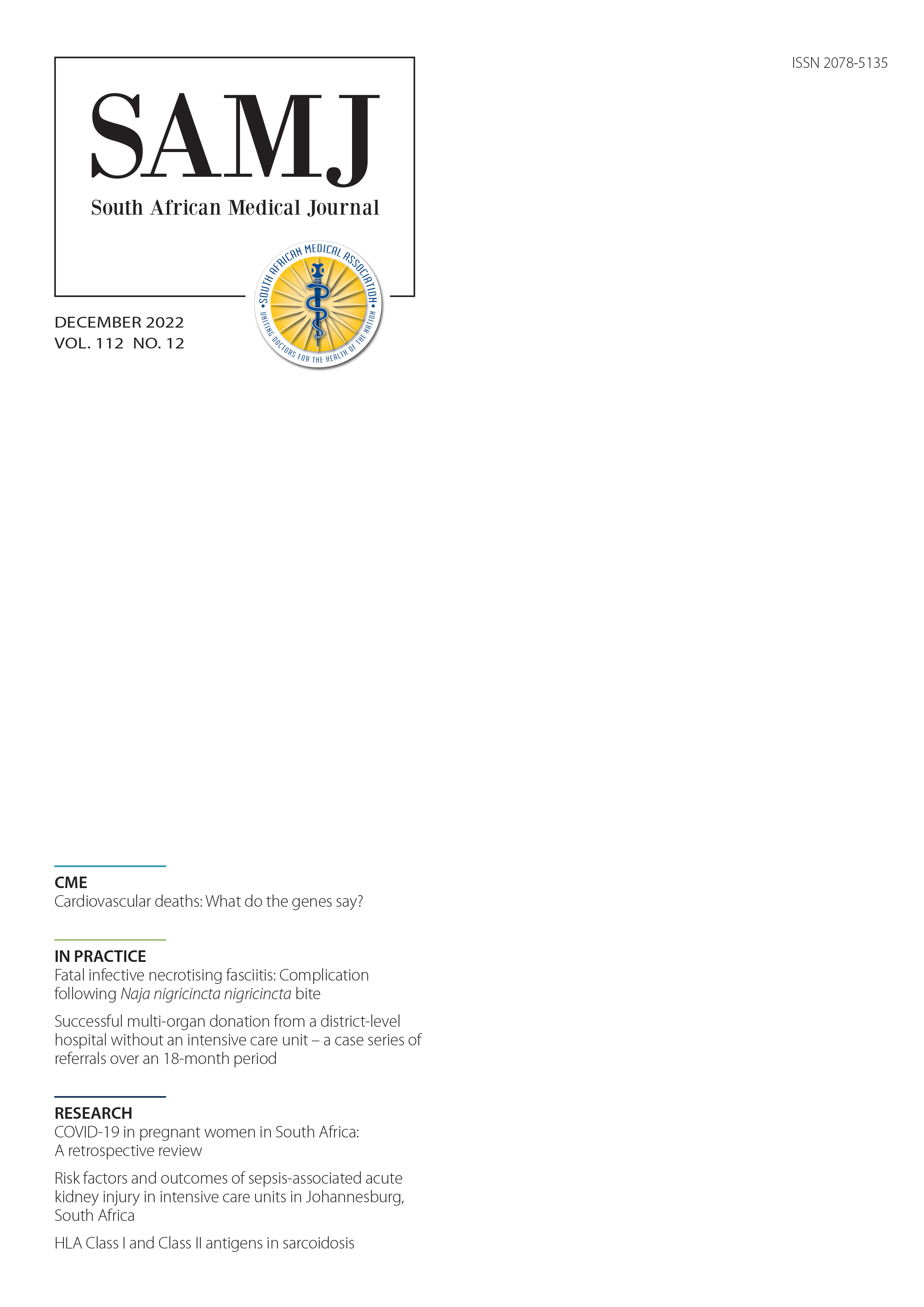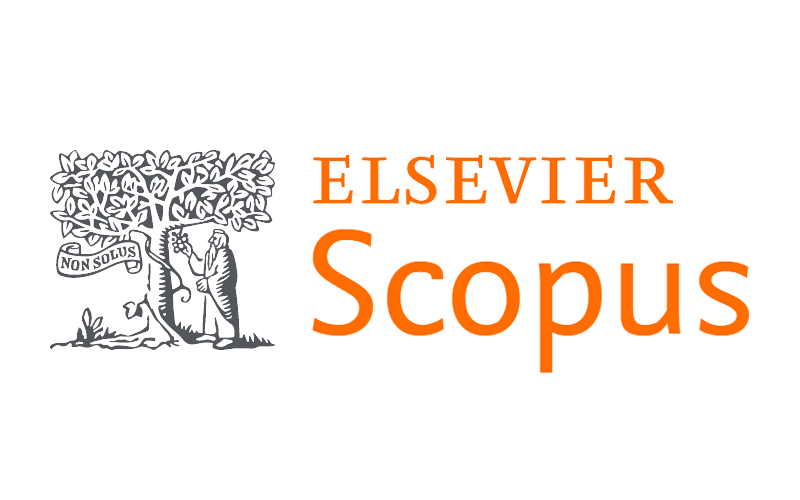HLA class I and class II antigens in sarcoidosis
DOI:
https://doi.org/10.7196/SAMJ.2022.v112i12.16586Keywords:
Sarcodosis, PopulationAbstract
Background. Sarcoidosis is a multisystem granulomatous disorder. Its exact cause is unknown, but it is believed that an external agent may cause the characteristic immune reaction in genetically susceptible individuals. There is therefore general recognition that genetic vulnerability to sarcoidosis is one of the potential risk factors. HLA is encoded by genes in the major histocompatibility complex on chromosome 6. These surface cells are important in presentation of antigen and play a key part in the body’s immune response to external antigens. Various HLA subtypes are more common in people with sarcoidosis than in those without. Variances in vulnerability, presentation, progression and prognosis have been related to different HLA phenotypes. HLA genes offer information into the factors driving sarcoidosis and prognosticating tools. However, in Africa, including South Africa (SA), there are no data on HLA types in relation to sarcoidosis.
Objectives. To determine HLA class I and II associations in SA sarcoidosis patients.
Methods. Phenotype frequencies of HLA-A, B and C and DQB1 and DRB1 were calculated for 51 consecutive patients with biopsy-proven sarcoidosis attending the respiratory clinic at Charlotte Maxeke Johannesburg Academic Hospital and 63 controls, who were potential organ donors. The frequencies of the tested HLA loci were determined by direct counting. The significance of the associations between the various loci tested for and the presence or absence of sarcoidosis was estimated from 2 × 2 tables using the χ2 test.
Results. Of the 51 patients, 70.6% were female. The mean age was 44.6 years. Analysis of HLA class I and class II phenotypes in sarcoidosis patients revealed a significant association with HLA-B15, C4, C7, C12, C15, C16, C17, DQ3, DR8 and DR11. In addition, a significant negative (protective) association with HLA A9, A28, B12, B17 and DR2 was observed.
Conclusion. This HLA study in SA patients suggests that genetic factors play a role in the causation of sarcoidosis. Some HLA subtypes
have a significant association with sarcoidosis in SA patients, while other subtypes may be protective. The study supported the association of HLA antigens with sarcoidosis and implies that there is a genetic predisposition to sarcoidosis in the SA population.
References
Hunninghake G, Costabel U, Ando M, et al. ATS/ERS/WASOG statement on sarcoidosis: American Thoracic Society/European Respiratory Society/World Association of Sarcoidosis and other Granulomatous Disorders. Sarcoidosis Vasc Diffuse Lung Dis 1999;16(2):149-173.
Grunewald J, Grutters JC, Arkema EV, Saketkoo LA, Moller DR, Müller-Quernheim J. Sarcoidosis. Nat Rev Dis Primers 2019;5(1):45. https://doi.org/10.1038/s41572-019-0096-x
Spagnolo P, Rossi G, Trisolini R, Sverzellati N, Baughman RP, Wells AU. Pulmonary sarcoidosis. Lancet Respir Med 2018;6(5):389-402. https://doi.org/10.1016/S2213-2600(18)30064-X
Spagnolo P, du Bois RM. Genetics of sarcoidosis. Clin Dermatol 2007;25(3):242-249. https://doi. org/10.1016/j.clindermatol.2007.03.001
Iannuzzi MC, Rybicki BA. Genetics of sarcoidosis: Candidate genes and genome scans. Proc Am Thorac Soc 2007;4(1):108-116. https://doi.org/10.1513/pats.200607-141JG
Berlin M, Fogdell-Hahn A, Olerup O, Eklund A, Grunewald J. HLA-DR predicts the prognosis in Scandinavian patients with pulmonary sarcoidosis. Am J Respir Crit Care Med 1997;156(5):1601- 1605. https://doi.org/10.1164/ajrccm.156.5.9704069
Abe S, Yamaguchi E, Makimura S, Okazaki N, Kunikane H, Kawakami Y. Association of HLA-DR with sarcoidosis: Correlation with clinical course. Chest 1987;92(3):488-490. https://doi.org/10.1378/ chest.92.3.488
Martinetti M, Tinelli C, Kolek V, et al. ‘The sarcoidosis map’: A joint survey of clinical and immunogenetic findings in two European countries. Am J Respir Crit Care Med 1995;152(2):557-564. https://doi.org/10.1164/ajrccm.152.2.7633707
Celik G, Şen E, Ülger A, et al. Human leukocyte antigens A and B in Turkish patients with sarcoidosis. Arch Bronconeumol 2004;40(10):449-452. https://doi.org/10.1016/s1579-2129(06)60354-6
Lenhart K, Kolek V, Bartova A. HLA antigens associated with sarcoidosis. Dis Markers 1990;8(1):23-29.
Kunikane H, Abe S, Tsuneta Y, et al. Role of HLA-DR antigens in Japanese patients with sarcoidosis.
Am Rev Respir Dis1987;135(3):688-691. https://doi.org/10.1164/arrd.1987.135.3.688
Pasturenzi L, Martinetti M, Cuccia M, Cipriani A, Semenzato G, Luisetti M. HLA class I, II, and III polymorphism in Italian patients with sarcoidosis. Chest 1993;104(4):1170-1175. https://doi.
org/10.1378/chest.104.4.1170
Beijer E, Veltkamp M, Meek B, Moller DR. Etiology and immunopathogenesis of sarcoidosis: Novel insights. Semin Respir Crit Care Med 2017;38(4):404-416. https://doi.org/10.1055/s-0037-1603087
Fiorillo MT, Paladini F, Tedeschi V, Sorrentino R. HLA class I or class II and disease association: Catch
the difference if you can. Front Immunol 2017;8:1475. https://doi.org/10.3389/fimmu.2017.01475
Hedfors E, Möller E. HL‐A antigens in sarcoidosis. Tissue Antigens 1973;3(2):95-98. 10.1111/j.1399-
1973.tb00983.x
Möller E, Hedfors E, Wiman L-G. HL‐A genotypes and MLR in familial sarcoidosis. Tissue Antigens
;4(3):299-305. https://doi.org/10.1111/j.1399-0039.1974.tb00256.x
Kueppers F, Mueller‐Eckhardt C, Heinrich D, Schwab B, Brackertz D. HL‐A antigens of patients with
sarcoidosis. Tissue Antigens 1974;4(1):56-58. https://doi.org/10.1111/j.1399-0039.1973.tb00983.x
Brewerton D, Cockburn C, James DC, James DG, Neville E. HLA antigens in sarcoidosis. Clin Exp
Immunol 1977;27(2):227-229.
Hedfors E, Lindström F. HLA‐B8/DR3 in sarcoidosis: Correlation to acute onset disease with arthritis.
Tissue Antigens 1983;22(3):200-203. https://doi.org/10.1111/j.1399-0039.1983.tb01192.x
Smith M, Turton C, Mitchell D, Turner-Warwick M, Morris L, Lawler S. Association of HLA B8 with
spontaneous resolution in sarcoidosis. Thorax 1981;36(4):296-298. https://doi.org/10.1136/thx.36.4.296
Lio D, Candore G, Romano GC, et al. Modification of cytokine patterns in subjects bearing the HLA-
B8,DR3 phenotype: Implications for autoimmunity. Cytokines Cell Mol Ther 1997;3(4):217-224.
Grunewald J, Eklund A, Olerup O. Human leukocyte antigen class I alleles and the disease course in sarcoidosis patients. Am J Respir Crit Care Med 2004;169(6):696-702. https://doi.org/10.1164/
rccm.200303-459OC
Rossman MD, Thompson B, Frederick M, et al. HLA-DRB1*1101: A significant risk factor for sarcoidosis in blacks and whites. Am J Hum Genet 2003;73(4):720-735. https://doi.org/10.1086/378097
Ishihara M, Ohno S, Ishida T, et al. Molecular genetic studies of HLA class II alleles in sarcoidosis.
Tissue Antigens 1994;43(4):238-241. https://doi.org/10.1111/j.1399-0039.1994.tb02331.x
Iannuzzi MC, Maliarik MJ, Poisson LM, Rybicki BA. Sarcoidosis susceptibility and resistance HLA- DQB1 alleles in African Americans. Am J Respir Crit Care Med 2003;167(9):1225-1231. https://doi. org/10.1164/rccm.200209-1097OC
Rybicki BA, Maliarik MJ, Poisson LM, et al. The major histocompatibility complex gene region and sarcoidosis susceptibility in African Americans. Am J Respir Crit Care Med 2003;167(3):444-449. https://doi.org/10.1164/rccm.2112060
Zachary AA, Bias WB, Johnson A, Rose SM, Leffell MS. Antigen, allele, and haplotype frequencies report of the ASHI minority antigens workshops: Part 1, African-Americans. Hum Immunol 2001;62(10):1127-1136. https://doi.org/10.1016/s0198-8859(01)00305-6
Moller DR, Chen ES. Genetic basis of remitting sarcoidosis: Triumph of the trimolecular complex? Am J Respir Cell Mol Biol 2002;27(4):391-395. https://doi.org/10.1165/rcmb.2002-0164PS
Odum N, Milman N, Jakobsen B, Georgsen J, Svejgaard A. HLA class II (DR, DQ, DP) in patients with sarcoidosis: Evidence of an increased frequency of DRw6. Exp Clin Immunogenet 1991;8(4):227-232. 30. Smith G, Brownell I, Sanchez M, Prystowsky S. Advances in the genetics of sarcoidosis. Clin Genet
;73(5):401-412. https://doi.org/10.1111/j.1399-0004.2008.00970.x
Sato H, Woodhead FA, Ahmad T, et al. Sarcoidosis HLA class II genotyping distinguishes differences
of clinical phenotype across ethnic groups. Hum Mol Genet 2010;19(20):4100-4111. https://doi.
org/10.1093/hmg/ddq325
Akokan G, Celiköglu S, Göksel F, Demirci S. Antigens in Turkish patients with sarcoidosis. N Engl J Med 1977;296(13):759.
Ozyilmaz E, Ozturk OG, Durmaz A, et al. Early prediction of sarcoidosis prognosis with HLA typing: A 5 year follow-up study. Sarcoidosis Vasc Diffuse Lung Dis 2018;35(3):184-191. https://doi. org/10.36141/svdld.v35i3.6781
Rybicki BA, Iannuzzi MC. Sarcoidosis and human leukocyte antigen class I and II genes: It takes two to tango? Am J Respir Crit Care Med 2004;169(6):665-666. https://doi.org/10.1164/rccm.2401005
Starshinova AA, Malkova AM, Basantsova NY, et al. Sarcoidosis as an autoimmune disease. Front Immunol 2019;10:2933. https://doi.org/10.3389/fimmu.2019.02933
Malkova A, Starshinova A, Zinchenko Y, et al. The opposite effect of human leukocyte antigen genotypes in sarcoidosis and tuberculosis: A narrative review of the literature. ERJ Open Res 2020;6(3):00155-2020. https://doi.org/10.1183/23120541.00155-2020
Downloads
Published
Issue
Section
License
Copyright (c) 2022 R Morar, R Duarte, A A Wadee, C Feldman

This work is licensed under a Creative Commons Attribution-NonCommercial 4.0 International License.
Licensing Information
The SAMJ is published under an Attribution-Non Commercial International Creative Commons Attribution (CC-BY-NC 4.0) License. Under this license, authors agree to make articles available to users, without permission or fees, for any lawful, non-commercial purpose. Users may read, copy, or re-use published content as long as the author and original place of publication are properly cited.
Exceptions to this license model is allowed for UKRI and research funded by organisations requiring that research be published open-access without embargo, under a CC-BY licence. As per the journals archiving policy, authors are permitted to self-archive the author-accepted manuscript (AAM) in a repository.
Publishing Rights
Authors grant the Publisher the exclusive right to publish, display, reproduce and/or distribute the Work in print and electronic format and in any medium known or hereafter developed, including for commercial use. The Author also agrees that the Publisher may retain in print or electronic format more than one copy of the Work for the purpose of preservation, security and back-up.





